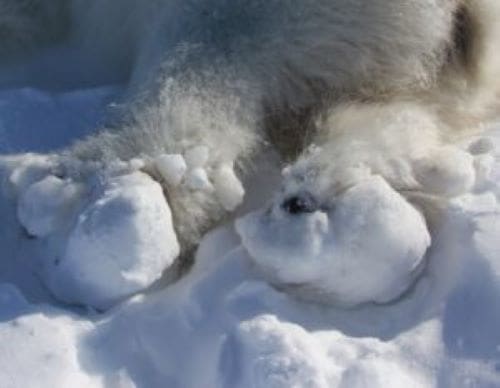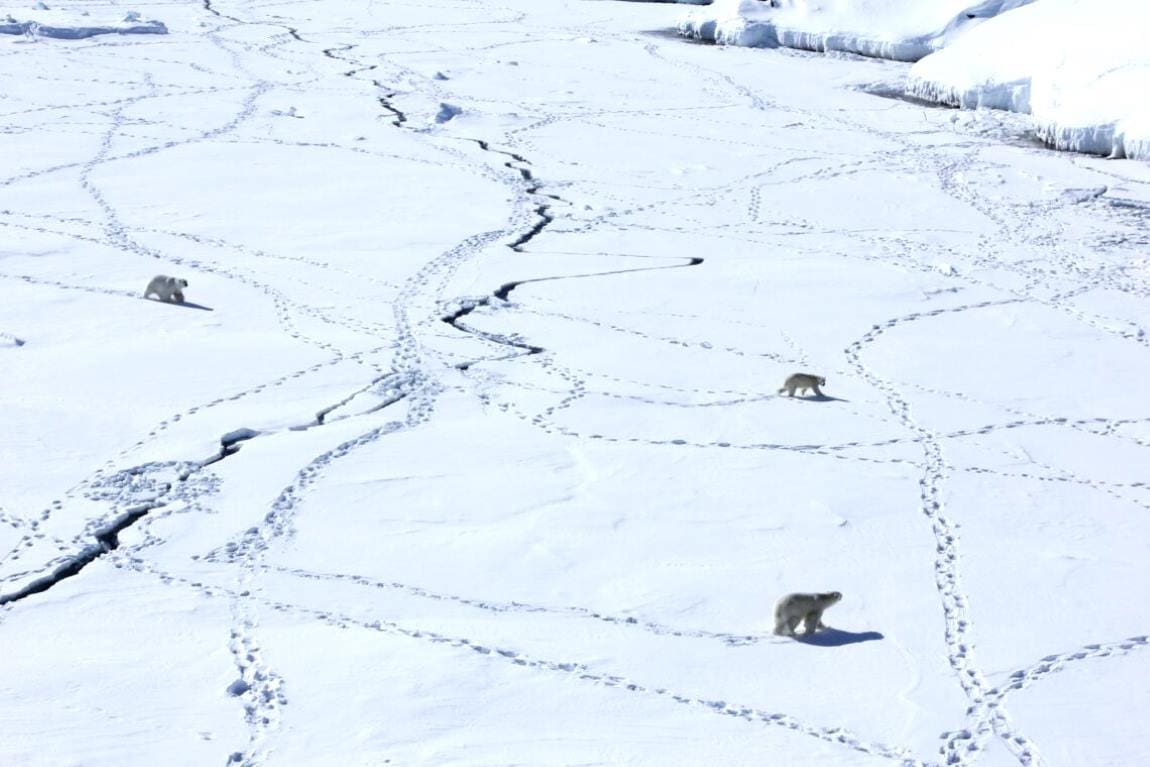Polar bears in the high Arctic are facing ice-related injuries to their feet, a previously undocumented phenomenon tied to the rapidly changing climate. A new study reveals that as the Arctic continues to warm, the transformation of sea ice conditions is taking a toll on these iconic predators, causing foot injuries that challenge their mobility and survival.
The study, led by the University of Washington, was published in the journal Ecology.
The researchers, surveying two polar bear populations between 2012 and 2022, found lacerations, hair loss, ice buildup, and skin ulcerations primarily affecting the bears’ feet, though other parts of their bodies were also impacted. Most alarmingly, two polar bears in East Greenland were discovered with ice blocks up to one foot (30 centimeters) in diameter stuck to their foot pads. These ice masses caused deep, bleeding cuts, making it difficult for the bears to walk.
Kristin Laidre, the lead author of the study and a senior scientist at the University of Washington’s Applied Physics Laboratory, emphasized the unprecedented nature of the findings. “In addition to the anticipated responses to climate change for polar bears, there are going to be other, unexpected responses,” Laidre noted. “As strange as it sounds, with climate warming, there are more frequent freeze-thaw cycles with more wet snow, and this leads to ice buildup on polar bears’ paws.”
The research team focused on two polar bear populations living above 70 degrees north latitude.

The Kane Basin population, located between Canada and Greenland, had 31 of 61 bears showing signs of icing-related injuries, such as hairless patches, cuts, or scarring. In the East Greenland population, 15 of 124 bears exhibited similar symptoms. Among the two Greenland bears with severe ice buildup, researchers noted that both struggled to walk and were clearly in pain.
“I’d never seen that before,” Laidre remarked. “The two most affected bears couldn’t run – they couldn’t even walk very easily. When immobilizing them for research, we very carefully removed the ice balls. The chunks of ice weren’t just caught up in the hair. They were sealed to the skin, and when you palpated the feet, it was apparent that the bears were in pain.”
These observations are unique; researchers have studied these polar bear populations since the 1990s without encountering such injuries. Consultations with Indigenous subsistence hunters and a review of the scientific literature suggest that this is a recent phenomenon, likely driven by climate change.
Polar bears have small bumps on their foot pads that help them maintain traction on slippery surfaces. These bumps are larger than those of other bear species, such as brown or black bears, making it easier for wet snow to freeze to their paws and accumulate, leading to injuries. This problem is not limited to polar bears; it is also seen in sled dogs that inhabit northern regions.
The researchers hypothesized three possible explanations for the increasing ice buildup on the bears’ feet, all of which are linked to a warming climate. One potential cause is the increasing frequency of rain-on-snow events, which create moist, slushy snow that clumps onto the bears’ paws. Once temperatures drop, the snow freezes into solid ice, leading to injuries. Another possibility is that warm spells are causing the snow to melt and refreeze into a hard crust, which sharp-edged snow can cut the bears’ paws as they walk through it. Lastly, the bears’ habitat – fast ice connected to the land, where freshwater glaciers meet the ocean – might also be a factor. The thinning sea ice allows seawater to seep into the snow, creating wet snow that clings to the paws before freezing.
Unlike other polar bear populations that swim long distances in spring, those living near glaciers’ edges may face increased vulnerability to this phenomenon because they rarely swim in warmer waters that could thaw and dislodge accumulated ice.
Despite the significant injuries observed, the researchers remain cautious about drawing broader conclusions about the health of these populations. “We’ve seen these icing-related injuries on individual polar bears,” Laidre said. “But I would hesitate to jump to conclusions about how this might affect them at a population level. We really don’t know.”
This research adds to the growing body of evidence that the Arctic is transforming in ways that present new challenges to the species that live there.
Melinda Webster, a research scientist at the University of Washington’s Applied Physics Laboratory, conducted a separate study on snow cover over Arctic sea ice. “The surface of Arctic sea ice is transforming with climate change,” Webster explained. “The sea ice has less snow in late spring and summer, and the snow that does exist is experiencing earlier, episodic melt and more frequent rain. All these things can create challenging surface conditions for polar bears to travel on.”
As climate change accelerates, scientists continue to emphasize the urgent need for action. When asked about what can be done to mitigate the risks faced by polar bears, Laidre had a clear message: “We can reduce greenhouse gas emissions and try to limit climate warming.”
The field observations in this study were funded by the governments of Canada, Denmark, Nunavut, and Greenland, with Laidre also affiliated with the Greenland Institute of Natural Resources.
Journal Reference:
Kristin L. Laidre, Stephen N. Atkinson, ‘Icing-related injuries in polar bears (Ursus maritimus) at high latitudes’, Ecology e4435 (2024). DOI: 10.1002/ecy.4435
Article Source:
Press Release/Material by University of Washington
Featured image: Three adult polar bears travel across sea ice in eastern Greenland. Environments in the Far North that would have stayed well below freezing now experience freeze-thaw cycles and wet snow due to a warming climate. Credit: Kristin Laidre | University of Washington




